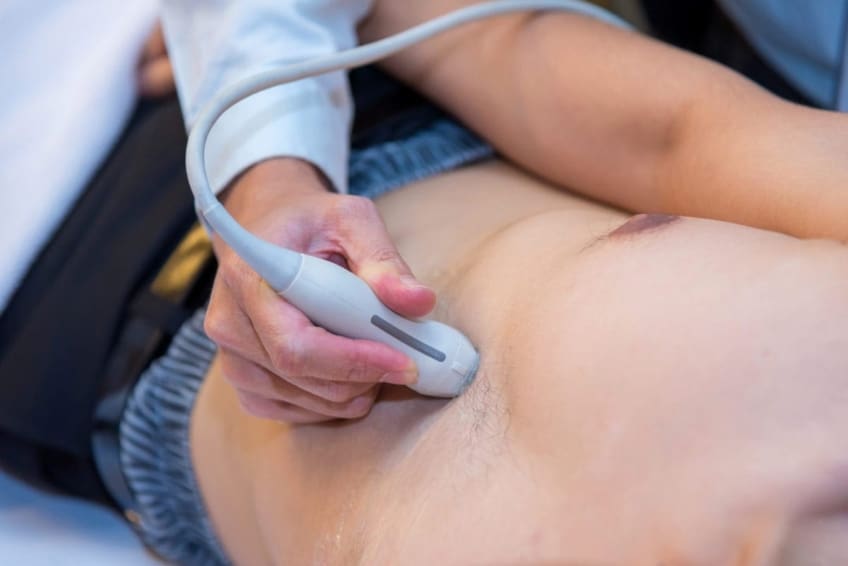
An abdominal ultrasound is an imaging test. It allows your doctor to look inside your abdomen (often referred to as your stomach or belly) without surgery. The abdomen is the part of your body that contains your stomach, large and small intestines, pancreas, liver, and gallbladder. It contains blood vessels, including the main artery that supplies blood from your heart (aorta), the large vein that carries blood to your heart (inferior vena cava) and all of its branches. Also, it contains muscles and your spine.
An abdominal ultrasound is safe. The test may cause only mild discomfort. It is performed on people of all ages. A trained medical technician moves a handheld device (called a wand) across your belly. The wand is connected to an ultrasound machine. As the technician moves the wand across your belly, it produces high-frequency sound waves. Those sound waves create real-time images and video of the inside of your belly. The images look similar to an X-ray. However, ultrasound picks up things that aren’t seen by an X-ray.
Before starting the process, the technician will apply a small amount of a clear gel to your stomach. This helps the wand move easily. The gel may feel cold.
Path to improved well being
Abdominal ultrasounds are performed on people who have unexplained abdominal pain or have had abdominal injuries. When you arrive for your ultrasound, you will be asked to undress and put on a light gown. You’ll lie on your back next to the ultrasound machine. A technician will apply the gel onto your abdomen and spread it around using the wand. The technician will watch the images as they appear on a nearby monitor. They will record the images for the doctor to review. The test typically takes less than 30 minutes to complete. You will not get results from the technician. They will send the images to your doctor to review. Your doctor’s office will contact you with the results.
An abdominal ultrasound is one of the primary tests used to find an abdominal aortic aneurysm. This is a medical condition that causes the artery that supplies blood to the lower part of your body to bulge. On rare occasions, the bulge can burst (called an abdominal aortic rupture). This can be dangerous, even deadly. When it bursts, it can cause internal bleeding and requires immediate medical attention.
Men who smoke or used to smoke are at a higher risk of having an aortic aneurysm. This is especially true for men over the age of 65. If you are a male who has ever smoked, and are between the ages of 65-75, talk to your doctor about an abdominal ultrasound to determine your risk for this condition. Others at risk for an aortic aneurysm include people who are white, have a family history of a thickening of artery walls, have high blood pressure, have had an aneurysm in another artery, or have severe obesity. If you are having an abdominal ultrasound for an aortic aneurysm, your doctor may have you fast (no food or liquid, except water) for 8 to 12 hours before your test. Having food and liquids in your stomach or urine in your bladder makes it difficult for the technician to see inside your abdomen. Other reasons your doctor may order this test include:
- To locate the cause of a kidney infection
- To diagnose and track tumor growth and cancer
- To diagnose or treat fluid buildup in your abdomen
- To check the swelling of organs inside the abdomen
- To examine the damage from an injury to your spleen
- To locate kidney or gallbladder stones
- To determine the cause of abnormal liver or kidney blood tests
- To check for unexplained causes of fever
- To guide a biopsy procedure (using a needle to take a sample of a tumor or tissue from your abdomen)
Things to consider
Your doctor will examine you before deciding if you should have an abdominal ultrasound. Ultrasounds do not expose you to radiation. You may have some mild discomfort as the wand is moved over the area of your abdominal pain.
An abdominal ultrasound is less effective on people who have severe obesity. Excess fat and tissue will block the technician’s view of organs and arteries. If your doctor recommends an abdominal ultrasound for your liver, gallbladder, spleen, or pancreas, eating a fatty meal before the test will limit the technician’s view of those organs.
Questions to ask your doctor
- Why would my doctor choose an abdominal ultrasound over an X-ray or a CT scan?
- Will an abdominal ultrasound expose my insides to anything harmful?
- If the technician finds that I have excess air inside my stomach or organs, will I be asked to return at another time?
- Can this be done in my doctor’s office?
Resources
National Institutes of Health, MedlinePlus: Abdominal Ultrasound
![]()
Copyright © American Academy of Family Physicians
This information provides a general overview and may not apply to everyone. Talk to your family doctor to find out if this information applies to you and to get more information on this subject.






